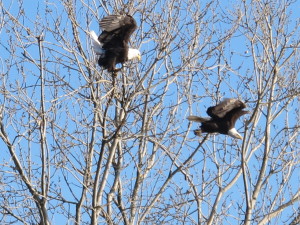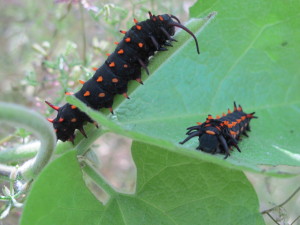



Area: 56 Acres
Location: Durham, Butte County
Date Acquired: 1997
Acquisition Type: CNLM Owned
Key Habitats: Valley Foothill Riparian, California Annual and Perennial Grassland
Species of Special Interest to CNLM: Steelhead (Oncorhynchusmykiss), Chinook Salmon (Oncorhynchustshawytscha) (Sacramento River: fall, late fall, and spring, Bald Eagle (Haliaeetusleucocephalus)
Introduction
The Keeney Preserve was established in 1997 with funding from the U.S. Fish and Wildlife Service’s Anadromous Fish Restoration Project. The Center for Natural Lands Management (CNLM) purchased 56 acres on Butte Creek to restore the Keeney Ranch, a former almond orchard, to riparian habitat. The Preserve was originally initiated as a mitigation project by the Butte County Fish and Game Commission.
Conservation Significance
Formerly agricultural land supporting almond crops, the Keeney Preserve is currently being restored to a native grassland and riparian forest landscape for the benefit of anadromous fish and other species. On the southeast side, the Keeney Preserve borders nearly a mile of Butte Creek, a waterway supporting the federally threatened steelhead trout (Oncorhynchusmykiss), and three seasonal runs of Chinook salmon (Oncorhynchustshawytscha). Butte Creek is one of the most important streams remaining in California for conservation of the federally threatened Sacramento River spring-run Chinook salmon. The spring-run, which may have been the most abundant race of salmon in California, is now limited to the Sacramento River and its tributaries. Spring-run salmon spend the summer in deep cool pools and spawn in early fall at higher elevations.
Butte Creek also supports fall-run Chinook salmon at levels slightly below those of the spring-run. These fish typically spawn in the downstream areas of Butte Creek. In winter, Bald eagles are frequently observed feeding on salmon. The headwaters of Butte Creek arise in the Lassen National Forest on the western slope of the Sierra Nevada Mountains and flow southwest through a deep canyon in the foothill region, then into the Central Valley flowing southeast of the city of Chico. From Chico, much of the stream is leveed, intensive agricultural development abuts the levees, and, in many places riparian habitat gives way to orchards within the extant floodplain. This section of the creek meanders in a southwesterly direction around the western side of the Sutter Buttes to its initial point of entry into the Sacramento River at Butte Slough. Butte Creek also enters the Sacramento River through the Sutter Bypass and Sacramento Slough.
Our Work
Our goal for the Keeney Preserve is to maintain and encourage the regeneration of native riparian vegetation and grassland habitats, reduce the presen ce of invasive exotic plants, and assess vegetation community composition and wildlife usage within the Preserve. We will document shifts in species composition and diversity as the site is restored to a more ‘natural’ state. Overall the riparian habitat has developed over the years and the vegetation has matured, creatinga more complex and diverse habitat structure. A fairly diverse assemblage of native plants occur in the relatively undisturbed riparian strip. Another significant portion of the Preserve contains young willows (Salix exigua, S. lasiolepis, S. gooddingii), cottonwoods (Populusfremonti), and California rose (Rosa californica). A few sapling white alders (Alnusrhombifolia), willows, and Oregon ash (Fraxinuslatifolia) are growing in the gap between the two primary strips of riparian vegetation in the Preserve.
ce of invasive exotic plants, and assess vegetation community composition and wildlife usage within the Preserve. We will document shifts in species composition and diversity as the site is restored to a more ‘natural’ state. Overall the riparian habitat has developed over the years and the vegetation has matured, creatinga more complex and diverse habitat structure. A fairly diverse assemblage of native plants occur in the relatively undisturbed riparian strip. Another significant portion of the Preserve contains young willows (Salix exigua, S. lasiolepis, S. gooddingii), cottonwoods (Populusfremonti), and California rose (Rosa californica). A few sapling white alders (Alnusrhombifolia), willows, and Oregon ash (Fraxinuslatifolia) are growing in the gap between the two primary strips of riparian vegetation in the Preserve.
Once connected, the Preserve may become suitable habitat for birds that typically will not cross these gaps. Non-native annual grasses and large patches of native perennial grasses now dominate the grassland habitat. The Preserve floods fairly frequently, and some natural regeneration, as occurred in 1997, will likely occur in the future. The Preserve functions as an island of habitat for many species not adapted to agricultural conditions.
Public Access
Due to the vulnerability of the species and habitats that exist on this preserve, it is not open to the public.
In 2003, 15 acres of the Preserve were approved as a mitigation bank. The service area is Butte County below 500 feet in elevation. Credits are for riparian habitat, some of which are available for jurisdictional-wetland credits. The proceeds of these sales are deposited in the Preserve endowment and provide funding for management of the Preserve in perpetuity.
Contact
For information on Keeney Preserve or Center for Natural Lands Management please contact Cathy Little, Regional Preserve Manager at clittle@cnlm.org or 760.731.7790 extension 209.


